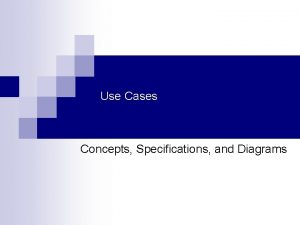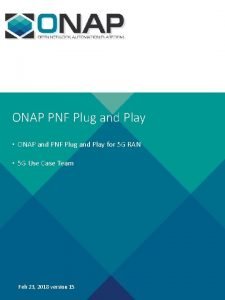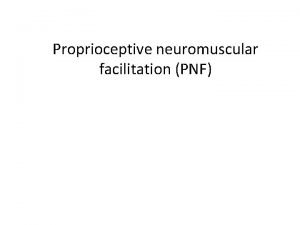ACTORS DESCRIPTION PNF PHYSICAL NETWORK FUNCTION PNF The







- Slides: 7

ACTORS DESCRIPTION PNF PHYSICAL NETWORK FUNCTION (PNF) – The Distributed Unit (DU) or Network Hardware device that provides service to an end-user. DHCP DYNAMIC HOST CONFIGURATION PROTOCOL (DHCP) – Protocol to assign dynamic IP addresses to a network element (NE). With dynamic addressing, a NE can have a different IP addresses when they connect to the network. SEGW SECURTIY GATEWAY – Protects against unsecured traffic from entering an internal network of a service provider; used by enterprises to protect their users from accessing and being infected by malicious traffic. CA/RA CERTIFICATE AUTHORITY / REGISTRATION AUTHORITY – Registers a User and authenticates a NE. Initial EM INITIAL EM – Provides basic configuration and software download services to the PNF. This might be a equipment vendor specific solution. Also, reponsible for identifying a PNF. v. DHCP – An entity within ONAP that can assign and manage IP Addresses. v. AAA (AUTHENTICATION, AUTHORIZATION, ACCOUNTING) – ONAP based authentication for a PNF to controlling access to the system, enforcing policies, auditing usage. SDN-C SOFTWARE DEFINED NETWORK CONTROLLER (SDN-C) – The network controller manages messages, DMaap Events, Inventory queries for the PNF to be onboarded. DCA&E DATA COLLECTION, ANALYTICS AND EVENTS (DCAE)– Gathers performance, usage, and configuration data from the managed environment. Collect, store data and provides a basis for analytics within ONAP. For PNF onboarding can potentially perform analytics on the onboarding process, statistics, logs. A&AI ACTIVE & AVAILABLE INVENTORY – The PNF is identified as available inventory and tracked through a key which is the PNF ID. When onboarded the PNF gets an entry in A&AI and can then be tracked, requested, and seen by the ONAP components for service requests or other queries. SO SERVICE ORCHESTRATOR – Serves as a mediator and coordinator of service requests. APP-C APPLICATION CONTROLLER (APP-C) - Manages the life cycle of virtual applications, virtual network functions (VNFs), and components. APPC receives and processes commands from other components.

PNF Bootstrapping Steps Factory Software Local DHCP SEGW CA/RA 1 SO: Service Definition 2 Preplanning, Pre-provisioning 3 HW Install 4 5 DHCP Discover VLAN Scanning IPv 4/IPv 6 discovery DHCP Response PNF IP@(m)*, Initial EM IP@ (m), SEGW IP@(o), CA IP@(o) *Temporary PNF IP@ 6 IPSec Tunnel Setup (optional) 7 Certificate Enrollment (optional) 8 Identity Service (Identifies NE), Gives ONAP IP@ 9 ONAP Bootstrap Software Download 10 PNF Restart Activates SW Initial EM

STEP DESCRIPTION 1 SO: SERVICE DEFINITION - A technician will provision the Service Definition which describes the type of VNF & PNF (CU & DU) units that will be instantiated. These are models that describe the type of units that we expect to support. Later, a correlation key (of the PNF ID) on the VID GUI is used to fetch what type of PNF to use based on the PNF ID. The PNF object instance is created based on this service definition. 2 PRE-PLANNING, PRE-PROVISIONING – There is data which is programmed into the system for the PNF onboarding operation. The user programs the local DHCP IP address(@), the Security Gateway IP@, the CA/RA certificate information, the management plane IP address (the ONAP IP@), the software service IP@ for use by the PNF during the onboarding process. 3 HW INSTALL – The physical hardware is installed at the site. Site licensing, real estate contacts, zoning, and physical hardware of the PNF is installed by technicians. Power, backhaul, and antennas are installed and connected. 4 INITIAL NETWORK ACCESS – A DHCP Discover procedure is executed when the PNF powers on, VLAN Scanning is performed, and IPv 4/IPv 6 discovery is done. The DHCP Discover message exchange provides an entryway into the network and is designed as an procedure for a network element to be able to find connection to the network from “scratch”. VLAN Scanning and IPv 4 vs IPv 6 discovery is done as well. 5 DHCP RESPONSE – The DHCP response returns a PNF IP address (optional), the initial EM IP address, Security Gateway IP address, and certificate authority IP address. It is possible that the PNF IP address is a temporary IP address just used for initial connectivity purposes, and that a static PNF IP address will be granted later. 6 IPSEC TUNNEL – An IP Sec Tunnel is established which uses cryptography to provides a secure connection. IPSec provides two security services: Authentication header and an encapsulating security payload. And there are two basic modes of IPSec: Tunnel Mode and Transport mode. 7 CERTIFICATE ENROLLMENT – A certificate exchange can be used to authenticate the PNF. A certificate mechanism can be used to verify the identity of two entities. Selfsigned certificates, certificate authorities may be used, and protocol exchanges such as X. 509 are examples of a certificate exchange. 8 IDENTITY SERVICE – The identity service is there to identify the PNF. It also returns the ONAP IP address 9 ONAP BOOTSTRAP SOFTWARE – The ONAP Bootstrap software is contacted by the PNF and download the ONAP bootstrap software. This is software package is meant to be able to perform the continuing steps PNF registration and activation onto ONAP 10 PNF RESET – The PNF is reset so that the downloaded ONAP Bootstrap software become activated and is then ready to continue to PNF registration

PNF Registration Steps PNF (DU) 11 v. DHCP SDN-C v. AAA DCAE AAI VES Event contains PNF ID, PNF IP@, Vendor Name 12 New PNF DMaa. P Event 13 Inventory Query 14 Authenticate & ID PNF* (optional) *May Assign “real” PNF IP@ 15 Configure real PNF IP@ (optional) 16 Register PNF (PNF ID, real IP@) Update/Create A&AI Entry

STEP DESCRIPTION 11 VES EVENT – The PNF generates a VES Event to DCAE which is the “triggering” event that tells ONAP that the PNF is trying to register. This VES event contains the PNF ID, which will serve as an identifying key within A&AI to seek for that particular PNF. The VES event also contains the PNF IP address and the vendor name amongst other things. 12 DMaa. P EVENT – When DCA&E receives the VES event, then DCA&E generates a DMaa. P event to SDN-C which indicates that a new PNF has been identified. 13 INVENTORY QUERY - SDN-C performs an inventory Query to A&AI. It might have been the case that the instance of this PNF has already been created or already exists within A&AI. It performs this query using the PNF ID as a key. 14 AUTHENTICATION - SDC uploads the serial# and MAC address into A&AI so that in this step SDN-C knows to expect a particular PNF hardware. This step is optional and is vendor dependent. Also, the PNF doesn’t need this step; it is a security measure for ONAP. Note that SDC would need a custom DG for PNF-based SDC data. 15 CONFIGURE PNF IP @ - If so desired, a static (permanent) IP address can be provided to the PNF in this step. The PNF would receive this IP address and use it starting at this point in the onboarding process. The IP address assigned from SDNC may come from the v. AAA, a local static pool of IP addresses. SDN-C performs the IP address selection if there will be a static IP address to be used by the PNF. Note, this step is optional and is not necessarily executed. 16 REGISTER PNF IN A&AI – The PNF is registered into A&AI using the PNF ID as a key. SDN-C has already performed an inventory query, and it might be the case that the PNF already exists, it might be the case that the PNF information needs to be updated, or lastly it might be the case that the PNF A&AI entry needs to be created. After this step, the PNF is considered to be registered into the ONAP and with an entry into A&AI becomes available as an network element to fulfil service requests.

PNF Activation Steps PNF (DU) SDN-C APP-C AAI SO SDC 1 Service Instantiation* (PNF ID, CU IP@) *Happens before or after PNF Registration 17 18 19 20 21 22 23 Inventory Query Service Configuration (CU IP@) Connection to VNF (DU contacts CU) Target SW Software Download DU Restart CU Configures the DU with operational configuration DU Restart CU (VNF)

STEP DESCRIPTION 1 SERVICE INSTANTIATION – The PNF is instantiated from the Service Definition. The service instantiation may occur before or after PNF registration. It is noted as step 1 because it might also happen during step 1, for pre-provisioning. The PNF ID is used as a key, and the CU IP @ is provisioned. 17 INVENTORY QUERY – SDN-C performs an A&AI query using the PNF ID as a key. 18 SERVICE CONFIGURATION - The SDN-C provides the CU IP @ to the DU, which will allow the DU to contact the CU. 19 CONNECTION TO VNF – Using the CU IP@ from the previous step, the DU makes contact with the CU. If the CU cannot be reached, the DU shall periodically retry. 20 TARGET SOFTWARE DOWNLOAD - The new Target Software is downloaded which is the RAN specific software that will replace the ONAP Bootstrap software. 21 DU RESTART –After the software successfully reboots, the Target Software becomes activated, and the PNF truly becomes a DU (Distributed Unit). 22 CU CONFIGURES DU – The configuration information is downloaded to the DU. This information provides operational configurations and settings which are vital for service. They would be pre-provisioned and allow the PNF to operate with specified configurations, optimizations, RF settings, connectivity, and L 1/L 2 algorithmic settings. 23 DU RESTART – The PNF (DU) is reset, which allows the new configuration parameters to take hold. And the DU is ready to provide service using the configuration provided to it.













